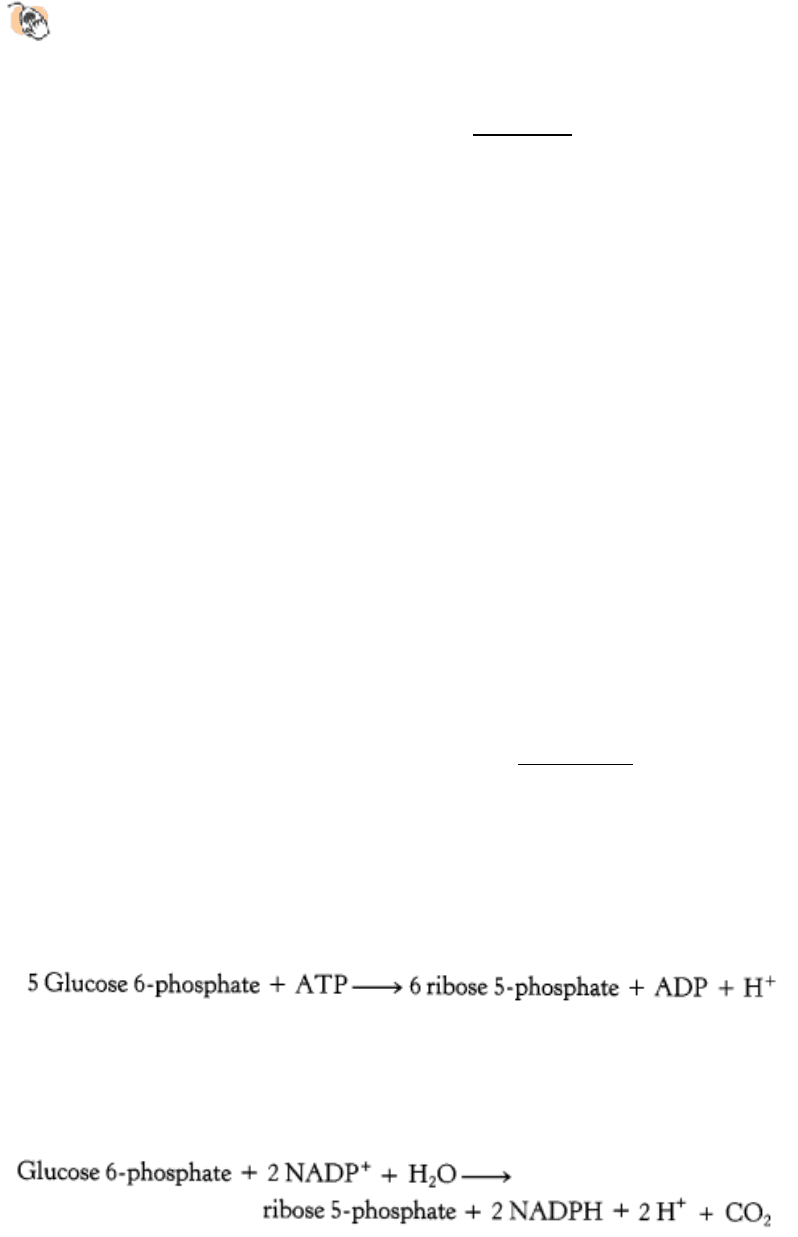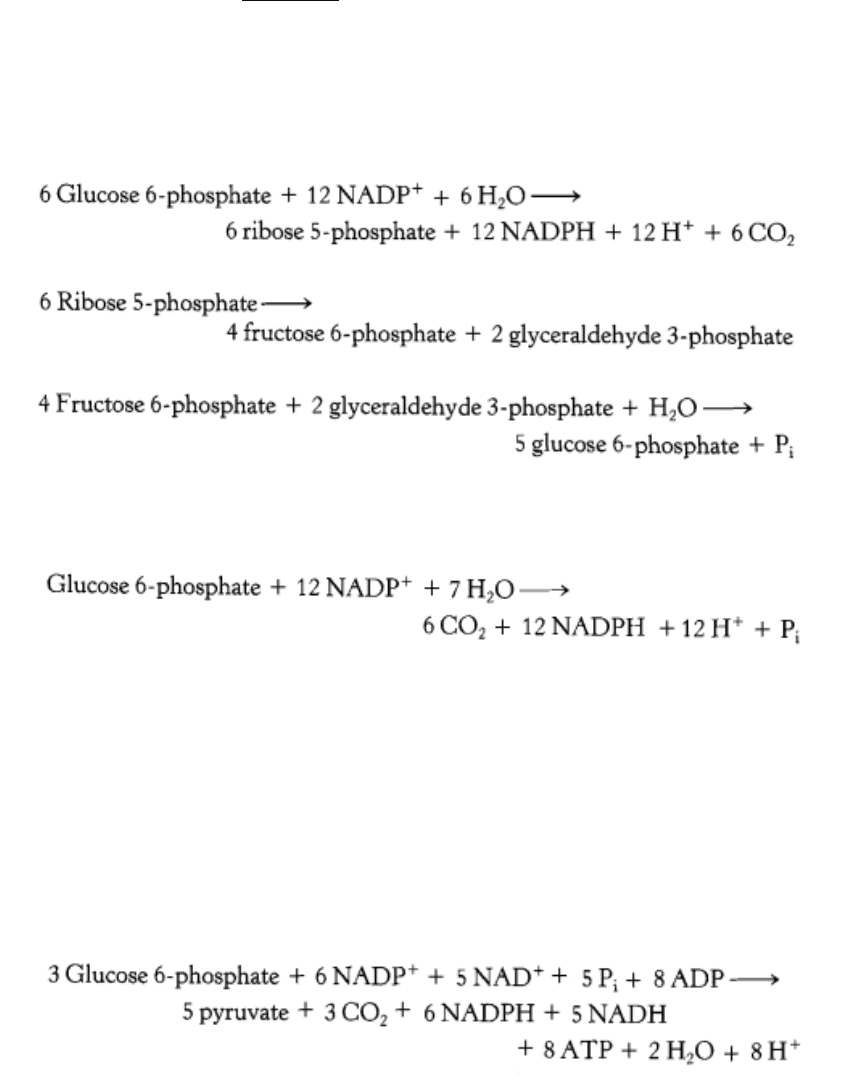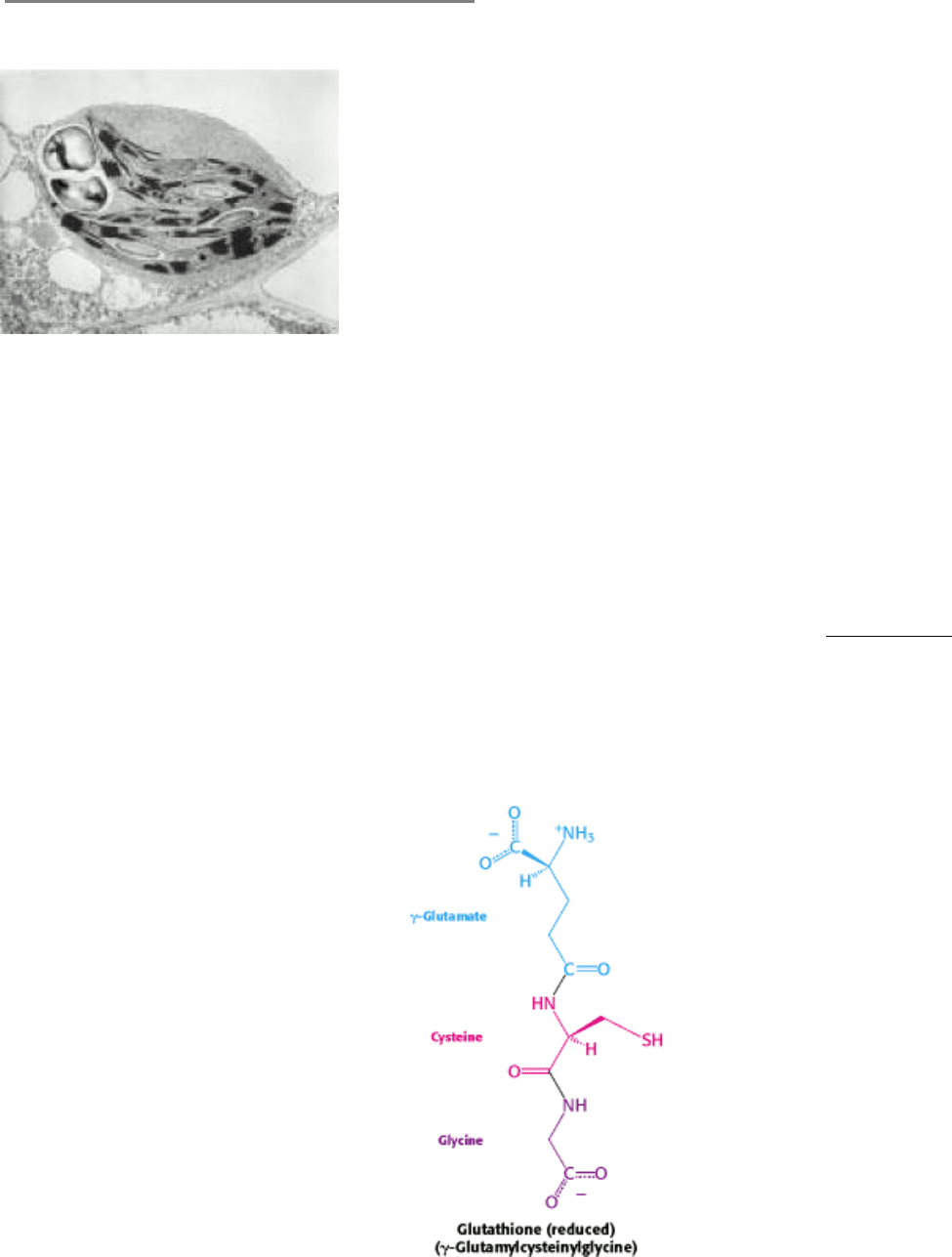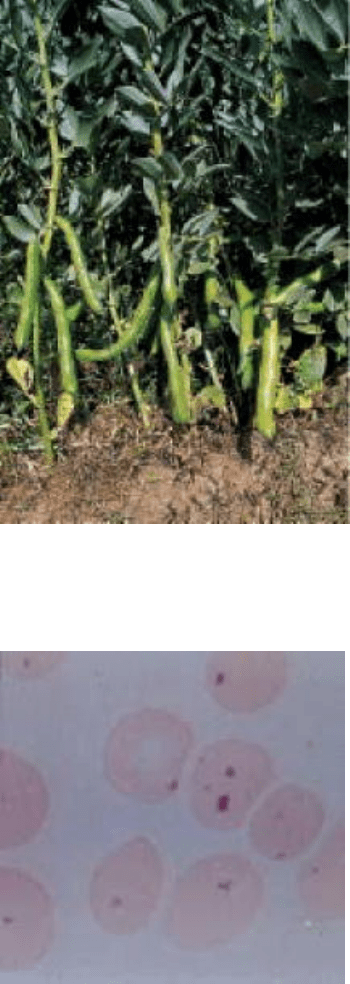Berg J.M., Tymoczko J.L., Stryer L. Biochemistry
Подождите немного. Документ загружается.


II. Transducing and Storing Energy 20. The Calvin Cycle and the Pentose Phosphate Pathway
20.4. The Metabolism of Glucose 6-Phosphate by the Pentose Phosphate Pathway Is
Coordinated with Glycolysis
Conceptual Insights, Overview of Carbohydrate and Fatty Acid Metabolism.
View this media module to gain a "bigger picture" understanding of the roles of
the pentose phosphate pathway in the context of other metabolic pathways
(glycolysis, citric acid cycle, glycogen and fatty acid metabolism).
Glucose 6-phosphate is metabolized by both the glycolytic pathway (Chapter 16) and the pentose phosphate pathway.
How is the processing of this important metabolite partitioned between these two metabolic routes? The cytoplasmic
concentration of NADP
+
plays a key role in determining the fate of glucose 6-phosphate.
20.4.1. The Rate of the Pentose Phosphate Pathway Is Controlled by the Level of NADP
+
The first reaction in the oxidative branch of the pentose phosphate pathway, the dehydrogenation of glucose 6-
phosphate, is essentially irreversible. In fact, this reaction is rate limiting under physiological conditions and serves as
the control site. The most important regulatory factor is the level of NADP
+
, the electron acceptor in the oxidation of
glucose 6-phosphate to 6-phosphoglucono-δ-lactone. The inhibitory effect of low levels of NADP
+
is exacerbated by the
fact that NADPH competes with NADP
+
in binding to the enzyme. The ratio of NADP
+
to NADPH in the cytosol of a
liver cell from a well-fed rat is about 0.014, several orders of magnitude lower than the ratio of NAD
+
to NADH, which
is 700 under the same conditions. The marked effect of the NADP
+
level on the rate of the oxidative phase ensures that
NADPH generation is tightly coupled to its utilization in reductive biosyntheses. The nonoxidative phase of the pentose
phosphate pathway is controlled primarily by the availability of substrates.
20.4.2. The Flow of Glucose 6-phosphate Depends on the Need for NADPH, Ribose 5-
phosphate, and ATP
We can grasp the intricate interplay between glycolysis and the pentose phosphate pathway by examining the
metabolism of glucose 6-phosphate in four different metabolic situations (Figure 20.24).
Mode 1. Much more ribose 5-phosphate than NADPH is required. For example, rapidly dividing cells need ribose 5-
phosphate for the synthesis of nucleotide precursors of DNA. Most of the glucose 6-phosphate is converted into fructose
6-phosphate and glyceraldehyde 3-phosphate by the glycolytic pathway. Transaldolase and transketolase then convert
two molecules of fructose 6-phosphate and one molecule of glyceraldehyde 3-phosphate into three molecules of ribose 5-
phosphate by a reversal of the reactions described earlier. The stoichiometry of mode 1 is
Mode 2. The needs for NADPH and ribose 5-phosphate are balanced. The predominant reaction under these conditions
is the formation of two molecules of NADPH and one molecule of ribose 5-phosphate from one molecule of glucose 6-
phosphate in the oxidative phase of the pentose phosphate pathway. The stoichiometry of mode 2 is

Mode 3. Much more NADPH than ribose 5-phosphate is required. For example, adipose tissue requires a high level of
NADPH for the synthesis of fatty acids (Table 20.4). In this case, glucose 6-phosphate is completely oxidized to CO
2
.
Three groups of reactions are active in this situation. First, the oxidative phase of the pentose phosphate pathway forms
two molecules of NADPH and one molecule of ribose 5-phosphate. Then, ribose 5-phosphate is converted into fructose
6-phosphate and glyceraldehyde 3-phosphate by transketolase and transaldolase. Finally, glucose 6-phosphate is
resynthesized from fructose 6-phosphate and glyceraldehyde 3-phosphate by the gluconeogenic pathway. The
stoichiometries of these three sets of reactions are
The sum of the mode 3 reactions is
Thus, the equivalent of glucose 6-phosphate can be completely oxidized to CO
2
with the concomitant generation of
NADPH. In essence, ribose 5-phosphate produced by the pentose phosphate pathway is recycled into glucose 6-
phosphate by transketolase, transaldolase, and some of the enzymes of the gluconeogenic pathway.
Mode 4. Both NADPH and ATP are required. Alternatively, ribose 5-phosphate formed by the oxidative phase of the
pentose phosphate pathway can be converted into pyruvate. Fructose 6-phosphate and glyceraldehyde 3-phosphate
derived from ribose 5-phosphate enter the glycolytic pathway rather than reverting to glucose 6-phosphate. In this mode,
ATP and NADPH are concomitantly generated, and five of the six carbons of glucose 6-phosphate emerge in pyruvate.
Pyruvate formed by these reactions can be oxidized to generate more ATP or it can be used as a building block in a
variety of biosyntheses.
20.4.3. Through the Looking Glass: The Calvin Cycle and the Pentose Phosphate
Pathway
The complexities of the Calvin cycle and the pentose phosphate pathway are easier to comprehend if we consider them
mirror images of each other. The Calvin cycle begins with the fixation of CO
2
and goes on to use NADPH in the
synthesis of glucose. The pentose phosphate pathway begins with the oxidation of a glucose-derived carbon atom to CO
2

and concomitantly generates NADPH. The regeneration phase of the Calvin cycle converts C
6
and C
3
molecules back
into the starting material
the C
5
molecule ribulose 1,5-bisphosphate. The pentose phosphate pathway converts a C
5
molecule, ribose 5-phosphate, into C
6
and C
3
intermediates of the glycolytic pathway. Not surprisingly, in
photosynthetic organisms, many enzymes are common to the two pathways. We see the economy of evolution: the use of
identical enzymes for similar reactions with different ends.
II. Transducing and Storing Energy 20. The Calvin Cycle and the Pentose Phosphate Pathway 20.4. The Metabolism of Glucose 6-Phosphate by the Pentose Phosphate Pathway Is Coordinated with Glycolysis
Figure 20.24. Four Modes of the Pentose Phosphate Pathway. Major products are shown in color.
II. Transducing and Storing Energy 20. The Calvin Cycle and the Pentose Phosphate Pathway 20.4. The Metabolism of Glucose 6-Phosphate by the Pentose Phosphate Pathway Is Coordinated with Glycolysis
Table 20.4. Tissues with active pentose phosphate pathways
Tissue Function
Adrenal gland Steroid synthesis
Liver Fatty acid and cholesterol synthesis
Testes Steroid synthesis
Adipose tissue Fatty acid synthesis
Ovary Steroid synthesis

Mammary gland Fatty acid synthesis
Red blood cells Maintenance of reduced glutathione
II. Transducing and Storing Energy 20. The Calvin Cycle and the Pentose Phosphate Pathway 20.4. The Metabolism of Glucose 6-Phosphate by the Pentose Phosphate Pathway Is Coordinated with Glycolysis
Electron micrograph of a chloroplast. The thylakoid membranes course throughout the stroma of a chloroplast from a
cell of Phleum pratense, a grass. The dark areas of stacked thylakoid membrane are grana. Several large starch granules,
which store the newly synthesized glucose, are also obvious. [Biophoto Associates/Photo Researchers.]
II. Transducing and Storing Energy 20. The Calvin Cycle and the Pentose Phosphate Pathway
20.5. Glucose 6-Phosphate Dehydrogenase Plays a Key Role in Protection Against
Reactive Oxygen Species
Reactive oxygen species (ROS) generated in oxidative metabolism inflict damage on all classes of macromolecules and
can ultimately lead to cell death. Indeed, ROS are implicated in a number of human diseases (Section 18.3.6). Reduced
glutathione (GSH), a tripeptide with a free sulfhydryl group, is required to combat oxidative stress and maintain the
normal reduced state in the cell. Oxidized glutathione (GSSG) is reduced by NADPH generated by glucose 6-phosphate
dehydrogenase in the pentose phosphate pathway. Indeed, cells with reduced levels of glucose 6-phosphate
dehydrogenase are especially sensitive to oxidative stress. This stress is most acute in red blood cells because, lacking
mitochondria, they have no alternative means of generating reducing power.
20.5.1. Glucose 6-phosphate Dehydrogenase Deficiency Causes a Drug-Induced

Hemolytic Anemia
At its introduction in 1926, an antimalarial drug, pamaquine, was associated with the appearance of severe and
mysterious ailments. Most patients tolerated the drug well, but a few developed severe symptoms within a few
days after therapy was started. The urine turned black, jaundice developed, and the hemoglobin content of the blood
dropped sharply. In some cases, massive destruction of red blood cells caused death.
This drug-induced hemolytic anemia was shown 30 years later to be caused by a deficiency of glucose 6-phosphate
dehydrogenase, the enzyme catalyzing the first step in the oxidative branch of the pentose phosphate pathway. This
defect, which is inherited on the X chromosome, is the most common enzymopathy, affecting hundreds of millions of
people. The major role of NADPH in red cells is to reduce the disulfide form of glutathione to the sulfhydryl form. The
enzyme that catalyzes the regeneration of reduced glutathione, the flavoprotein glutathione reductase, a dimer of 50-kd
subunits, is homologous to ferredoxin-NADP
+
reductase, which we encountered in photosynthesis (Section 19.3.4). The
reduced form of glutathione serves as a sulfhydryl buffer that maintains the cysteine residues of hemoglobin and other
red-blood-cell proteins in the reduced state. Normally, the ratio of the reduced to oxidized forms of glutathione in red
blood cells is 500.
How is GSH regenerated from GSSG and NADPH by glutathione reductase? The electrons from NADPH are not
directly transferred to the disulfide bond in oxidized glutathione. Rather, they are transferred from NADPH to a tightly
bound flavin adenine dinucleotide (FAD) on the reductase, then to a disulfide bridge between two cysteine residues in
the enzyme subunit, and finally to oxidized glutathione.
Reduced glutathione is essential for maintaining the normal structure of red blood cells and for keeping hemoglobin in
the ferrous state. The reduced form also plays a role in detoxification by reacting with hydrogen peroxide and organic
peroxides.
Cells with a lowered level of reduced glutathione are more susceptible to hemolysis. How can we explain this
phenomenon biochemically? The presence of pamaquine, a purine glycoside of fava beans, or other nonenzymatic
oxidative agents leads to the generation of peroxides, reactive oxygen species that can damage membranes as well as
other biomolecules. Peroxides are normally eliminated by glutathione peroxidase with the use of glutathione as a
reducing agent (Section 24.4). Moreover, in the absence of the enzyme, the hemoglobin sulfhydryl groups can no longer
be maintained in the reduced form and hemoglobin molecules then cross-link with one another to form aggregates called
Heinz bodies on cell membranes (Figure 20.25). Membranes damaged by the Heinz bodies and reactive oxygen species
become deformed and the cell is likely to undergo lysis. In the absence of oxidative stress, however, the deficiency is
quite benign. The occurrence of this dehydrogenase deficiency also clearly demonstrates that atypical reactions to drugs
may have a genetic basis.
20.5.2. A Deficiency of Glucose 6-phosphate Dehydrogenase Confers an Evolutionary
Advantage in Some Circumstances
The incidence of the most common form of glucose 6-phosphate dehydrogenase deficiency, characterized by a
tenfold reduction in enzymatic activity in red blood cells, is 11% among Americans of African heritage. This high
frequency suggests that the deficiency may be advantageous under certain environmental conditions. Indeed, glucose 6-
phosphate dehydrogenase deficiency protects against falciparum malaria. The parasites causing this disease require
reduced glutathione and the products of the pentose phosphate pathway for optimal growth. Thus, glucose 6-phosphate
dehydrogenase deficiency is a mechanism of protection against malaria, which accounts for its high frequency in malaria-
infested regions of the world. We see here once again the interplay of heredity and environment in the production of
disease.

II. Transducing and Storing Energy 20. The Calvin Cycle and the Pentose Phosphate Pathway 20.5. Glucose 6-Phosphate Dehydrogenase Plays a Key Role in Protection Against Reactive Oxygen Species
Vicia faba. The Mediterranean plant Vicia faba is a source of fava beans that contain the purine glycoside vicine. [Inga
Spence/ Visuals Unlimited.]
II. Transducing and Storing Energy 20. The Calvin Cycle and the Pentose Phosphate Pathway 20.5. Glucose 6-Phosphate Dehydrogenase Plays a Key Role in Protection Against Reactive Oxygen Species
Figure 20.25. Red Blood Cells with Heinz Bodies. The light micrograph shows red blood cells obtained from a person
deficient in glucose 6-phosphate dehydrogenase. The dark particles, called Heinz bodies, inside the cells are clumps of
denatured protein that adhere to the plasma membrane and stain with basic dyes. Red blood cells in such people are
highly susceptible to oxidative damage. [Courtesy of Dr. Stanley Schrier.]

II. Transducing and Storing Energy 20. The Calvin Cycle and the Pentose Phosphate Pathway
Summary
The Calvin Cycle Synthesizes Hexoses from Carbon Dioxide and Water
ATP and NADPH formed in the light reactions of photosynthesis are used to convert CO
2
into hexoses and other organic
compounds. The dark phase of photosynthesis, called the Calvin cycle, starts with the reaction of CO
2
and ribulose 1,5-
bisphosphate to form two molecules of 3-phosphoglycerate. The steps in the conversion of 3-phosphoglycerate into
fructose 6-phosphate and glucose 6-phosphate are like those of gluconeogenesis, except that glyceraldehyde 3-phosphate
dehydrogenase in chloroplasts is specific for NADPH rather than NADH. Ribulose 1,5-bisphosphate is regenerated from
fructose 6-phosphate, glyceraldehyde 3-phosphate, and dihydroxyacetone phosphate by a complex series of reactions.
Several of the steps in the regeneration of ribulose 1,5-bisphosphate are like those of the pentose phosphate pathway.
Three molecules of ATP and two molecules of NADPH are consumed for each molecule of CO
2
converted into a
hexose. Starch in chloroplasts and sucrose in the cytosol are the major carbohydrate stores in plants.
The Activity of the Calvin Cycle Depends on Environmental Conditions
Reduced thioredoxin formed by the light-driven transfer of electrons from ferredoxin activates enzymes of the Calvin
cycle by reducing disulfide bridges. The light-induced increase in pH and Mg
2+
level of the stroma is important in
stimulating the carboxylation of ribulose 1,5-bisphosphate by ribulose 1,5-bisphosphate carboxylase. This enzyme also
catalyzes a competing oxygenase reaction, which produces phosphoglycolate and 3-phosphoglycerate. The recycling of
phosphoglycolate leads to the release of CO
2
and further consumption of O
2
in a process called photorespiration. This
wasteful side reaction is minimized in tropical plants, which have an accessory pathway called the C
4
pathway for
concentrating CO
2
at the site of the Calvin cycle. This pathway enables tropical plants to take advantage of high levels of
light and minimize the oxygenation of ribulose 1,5-bisphosphate. Plants in arid ecosystems employ Crassulacean acid
metabolism (CAM) to prevent dehydration. In CAM plants, the C
4
pathway is active during the night when the plant
exchanges gases with the air. During the day, gas exchange is eliminated and CO
2
is generated from malate stored in
vacuoles.
The Pentose Phosphate Pathway Generates NADPH and Synthesizes Five-Carbon
Sugars
Whereas the Calvin cycle is present only in photosynthetic organisms, the pentose phosphate pathway is present in all
organisms. The pentose phosphate pathway generates NADPH and ribose 5-phosphate in the cytosol. NADPH is used in
reductive biosyntheses, whereas ribose 5-phosphate is used in the synthesis of RNA, DNA, and nucleotide coenzymes.
The pentose phosphate pathway starts with the dehydrogenation of glucose 6-phosphate to form a lactone, which is
hydrolyzed to give 6-phosphogluconate and then oxidatively decarboxylated to yield ribulose 5-phosphate. NADP
+
is
the electron acceptor in both of these oxidations. The last step is the isomerization of ribulose 5-phosphate (a ketose) to
ribose 5-phosphate (an aldose). A different mode of the pathway is active when cells need much more NADPH than
ribose 5- phosphate. Under these conditions, ribose 5-phosphate is converted into glyceraldehyde 3-phosphate and
fructose 6-phosphate by transketolase and transaldolase. These two enzymes create a reversible link between the pentose
phosphate pathway and glycolysis. Xylulose 5-phosphate, sedoheptulose 7-phosphate, and erythrose 4-phosphate are
intermediates in these interconversions. In this way, 12 molecules of NADPH can be generated for each molecule of
glucose 6-phosphate that is completely oxidized to CO
2
.
The Metabolism of Glucose 6-phosphate by the Pentose Phosphate Pathway Is
Coordinated with Glycolysis
Only the nonoxidative branch of the pathway is significantly active when much more ribose 5-phosphate than NADPH
needs to be synthesized. Under these conditions, fructose 6-phosphate and glyceraldehyde 3-phosphate (formed by the
glycolytic pathway) are converted into ribose 5-phosphate without the formation of NADPH. Alternatively, ribose 5-
phosphate formed by the oxidative branch can be converted into pyruvate through fructose 6-phosphate and
glyceraldehyde 3-phosphate. In this mode, ATP and NADPH are generated, and five of the six carbons of glucose 6-
phosphate emerge in pyruvate. The interplay of the glycolytic and pentose phosphate pathways enables the levels of
NADPH, ATP, and building blocks such as ribose 5-phosphate and pyruvate to be continuously adjusted to meet cellular
needs.
Glucose 6-phosphate Dehydrogenase Plays a Key Role in Protection Against Reactive
Oxygen Species
NADPH generated by glucose 6-phosphate dehydrogenase maintains the appropriate levels of reduced glutathione
required to combat oxidative stress and maintain the proper reducing environment in the cell. Cells with diminished
glucose 6-phosphate dehydrogenase activity are especially sensitive to oxidative stress.
Key Terms
Calvin cycle (dark reactions)
autotroph
heterotroph
rubisco (ribulose 1,5-bisphosphate carboxylase/oxygenase)
peroxisome
photorespiration
starch
sucrose
thioredoxin
C
4
pathway
C
4
plant
C
3
plant
Crassulacean acid metabolism (CAM)
pentose phosphate pathway
glucose 6-phosphate dehydrogenase
transketolase

transaldolase
glutathione
II. Transducing and Storing Energy 20. The Calvin Cycle and the Pentose Phosphate Pathway
Problems
1.
Variation on a theme. Sedoheptulose 1,7-bisphosphate is an intermediate in the Calvin cycle but not in the pentose
phosphate pathway. What is the enzymatic basis of this difference?
See answer
2.
Total eclipse. An illuminated suspension of Chlorella is actively carrying out photosynthesis. Suppose that the light
is suddenly switched off. How would the levels of 3-phosphoglycerate and ribulose 1,5-bisphosphate change in the
next minute?
See answer
3.
CO
2
deprivation. An illuminated suspension of Chlorella is actively carrying out photosynthesis in the presence of
1% CO
2
. The concentration of CO
2
is abruptly reduced to 0.003%. What effect would this reduction have on the
levels of 3-phosphoglycerate and ribulose 1,5-bisphosphate in the next minute?
See answer
4.
A potent analog. 2-Carboxyarabinitol 1,5-bisphosphate (CABP) has been useful in studies of rubisco.
(a) Write the structural formula of CABP.
(b) Which catalytic intermediate does it resemble?
(c) Predict the effect of CABP on rubisco.
See answer
5.
Salvage operation. Write a balanced equation for the transamination of glyoxylate to yield glycine.
See answer
6.
When one equals two. In the C
4
pathway, one ATP molecule is used in combining the CO
2
with
phosphoenolpyruvate to form oxaloacetate (Figure 20.17), but, in the computation of energetics bookkeeping, two
ATP molecules are said to be consumed. Explain.
See answer
7.
Dog days of August. Before the days of pampered lawns, most homeowners practiced horticultural Darwinism. A
result was that the lush lawns of early summer would often convert into robust cultures of crabgrass in the dog days
of August. Provide a possible biochemical explanation for this transition.
See answer

8.
Global warming. C
3
plants are most common in higher latitudes and become less common at latitudes near the
equator. The reverse is true of C
4
plants. How might global warming affect this distribution?
See answer
9.
Tracing glucose. Glucose labeled with
14
C at C-6 is added to a solution containing the enzymes and cofactors of the
oxidative phase of the pentose phosphate pathway. What is the fate of the radioactive label?
See answer
10.
Recurring decarboxylations. Which reaction in the citric acid cycle is most analogous to the oxidative
decarboxylation of 6-phosphogluconate to ribulose 5-phosphate? What kind of enzyme-bound intermediate is
formed in both reactions?
See answer
11.
Carbon shuffling. Ribose 5-phosphate labeled with
14
C at C-1 is added to a solution containing transketolase,
transaldolase, phosphopentose epimerase, phosphopentose isomerase, and glyceraldehyde 3-phosphate. What is the
distribution of the radioactive label in the erythrose 4-phosphate and fructose 6-phosphate that are formed in this
reaction mixture?
See answer
12.
Synthetic stoichiometries. What is the stoichiometry of synthesis of (a) ribose 5-phosphate from glucose 6-
phosphate without the concomitant generation of NADPH; (b) NADPH from glucose 6-phosphate without the
concomitant formation of pentose sugars?
See answer
13.
Trapping a reactive lysine. Design a chemical experiment to identify the lysine residue that forms a Schiff base at
the active site of transaldolase.
See answer
14.
Reductive power. What ratio of NADPH to NADP
+
is required to sustain [GSH] = 10 mM and [GSSG] = 1 mM?
Use the redox potentials given in Table 18.1.
See answer
Mechanism Problems
15.
An alternative approach. The mechanisms of some aldolases do not include Schiff-base intermediates. Instead,
these enzymes require bound metal ions. Propose such a mechanism for the conversion of dihydroxyacetone
phosphate and glyceraldehyde 3-phosphate into fructose 1,6-bisphosphate.
See answer
